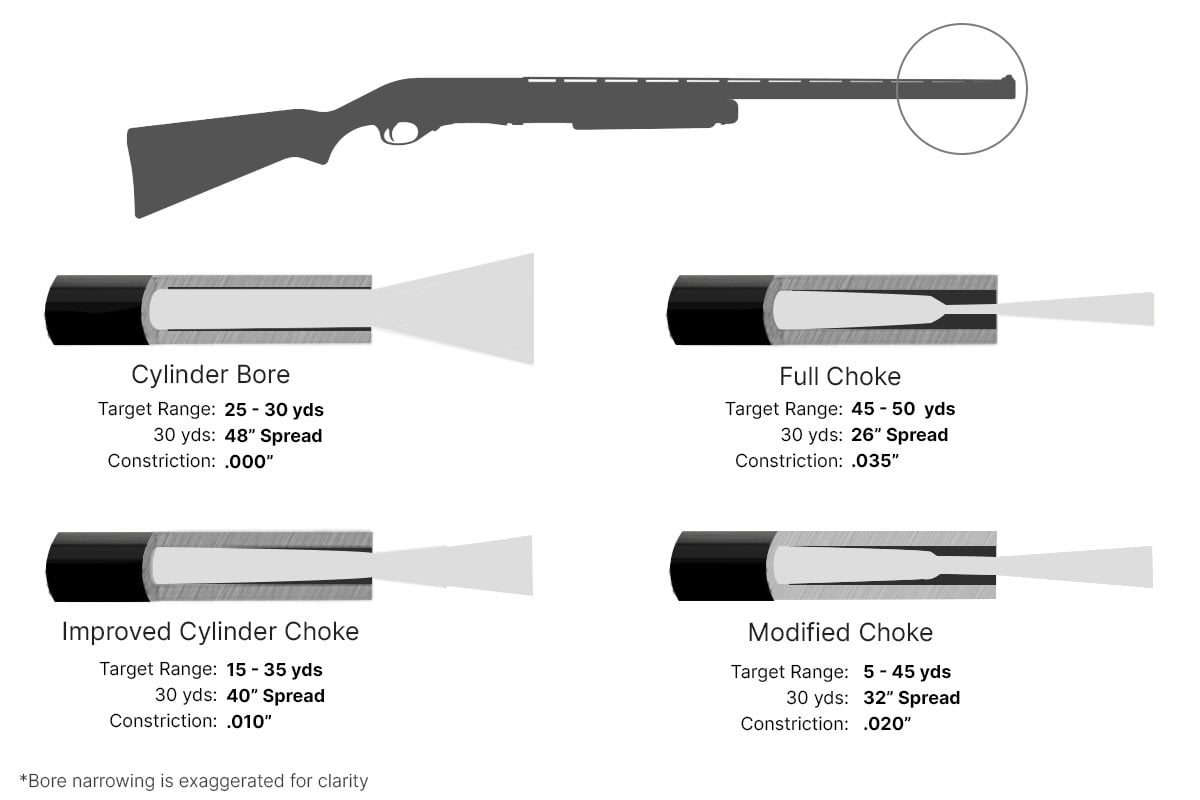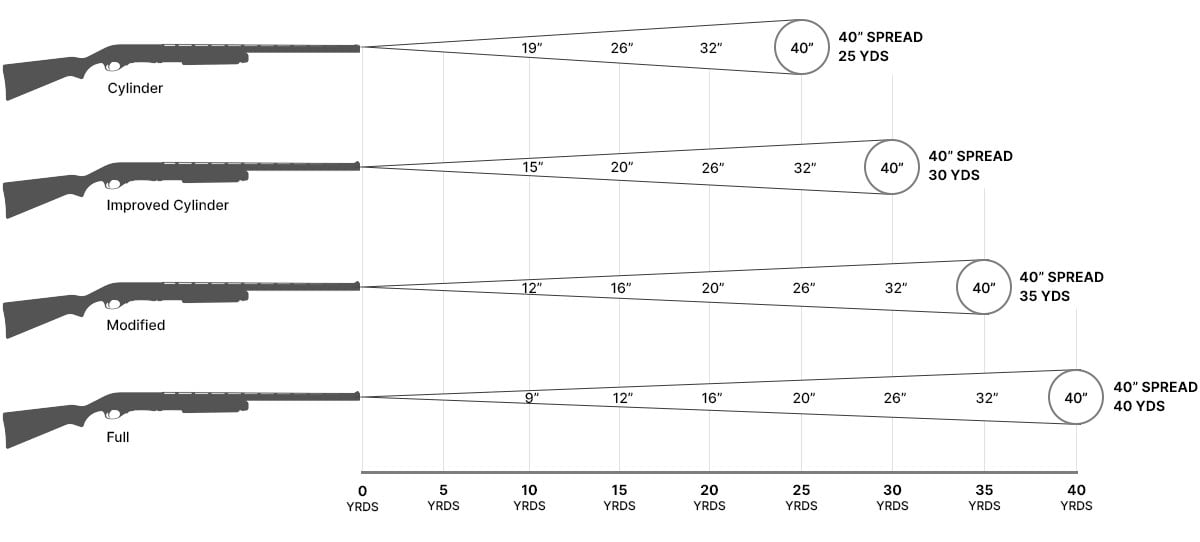Shotgun Choke Chart
From novice shooters to seasoned hunters, chokes are a critical component to getting the best out of your shotgun. Shotgun chokes are interchangeable tubes, installed at the end of a shotgun’s barrel that shape or narrow the shot pattern. A choke controls the range, density, pattern and overall accuracy of your shot making it an important component to your shotgun. In this guide, we cover the different kinds of shotgun chokes, what they do and which choke is best suited for your needs.

The Cylinder Choke is the most unrestricted and open choke. It offers a wide pattern ideal for shooting at close range or situations when a shooter needs a wide spread. This choke is primarily used for shooting fast moving targets such as clay pigeons or game that requires rapid target acquisition.
Improved Cylinder Choke provides more constriction than the cylinder choke. It offers a tighter shot pattern and an extended range, usually used for hunting smaller game at short to moderate distances. The Improved Cylinder Choke balances shot spread and range, making it a versatile choke.
The Full Choke offers the tightest constriction, creating a dense shot pattern with minimal spread. Best used for longer distances, this choke is ideal for waterfowl and trap shooting due to its maximum shot density at distance.
The Modified Choke provides moderate constriction with a tighter constriction than the improved cylinder choke. This versatile choke offers shooters a balance between spread and range, making it ideal for clays, upland game and waterfowl.
Percentage of Shot on 30" Target
| Choke Size | Restriction | 20 Yards | 30 Yards | 40 Yards | 50 Yards | 60 Yards |
|---|---|---|---|---|---|---|
| Cylinder Bore | 0.000" | 80% | 60% | 40% | 27% | 18% |
| Skeet | 0.005" | 92% | 72% | 50% | 33% | 22% |
| Improved Cylinder | 0.010" | 100% | 77% | 55% | 38% | 25% |
| Modified | 0.020" | 100% | 83% | 60% | 41% | 27% |
| Improved Modified | 0.030" | 100% | 91% | 65% | 46% | 30% |
| Full | 0.040" | 100% | 100% | 70% | 49% | 32% |
A choke concentrates the pellets in a shotgun, so they create a tighter pattern. A 30-inch pattern can be accomplished with all four standard chokes, but the difference comes in distance.
A cylinder choke has the widest pattern, meaning it will hit within a 30-inch target at 25 to 30 yards. At the other extreme is the full choke, which packs those pellets into a much tighter pattern, that fits inside a 30-inch circle at 50 yards.
The more pellets you keep inside that circle, the more energy you deliver.
For close range skeet shooting, a cylinder bore works great. But if you’re trying to harvest a tough Canada goose, you need to keep those pellets in a tight pattern at a distance to deliver the maximum punch.
40" Pattern spreads

A 40-inch pattern gives you a larger area of shot concentration which increases your chances of exploding a clay in skeet shooting or downing a pheasant as it bursts out of the brush in front of you.
All four patterns, cylinder, modified, improved, and full will deliver a 40-inch pattern, they just deliver it at progressively greater distances.
For skeet shooting or smaller birds like doves, a cylinder choke that delivers that 40-inch pattern at closer distances is ideal. For turkeys in heavy brush, a full choke comes into play. The greater distance requires a tighter shot to deliver enough pellets to ethically take a big turkey.
Choke Type Uses
| Type | Constriction | Effective range | Use |
|---|---|---|---|
| Cylinder Bore | .000" | 25 - 30 yds |
|
| Improved Cylinder | .010" | 15 - 35 yds |
|
| Modified | .020" | 25 - 45 yds |
|
| Full | .035" | 45 - 55 yds |
|
Starting with the cylinder, which is just the shotgun barrel without any improvements, and moving gradually to improved cylinder, modified cylinder, and finally full the pattern gets progressively tighter. Chokes increase or decrease pellet concentration for specific styles of shooting. This improves the effectiveness by spreading out or tightening the shot pattern over distance.
Small birds like doves and teal or skeet shooting work well with the widest pattern, the cylinder choke, while taking larger game, up to deer with buckshot, is reserved for a full choke that will deliver the maximum energy in a tighter pattern at longer distances.